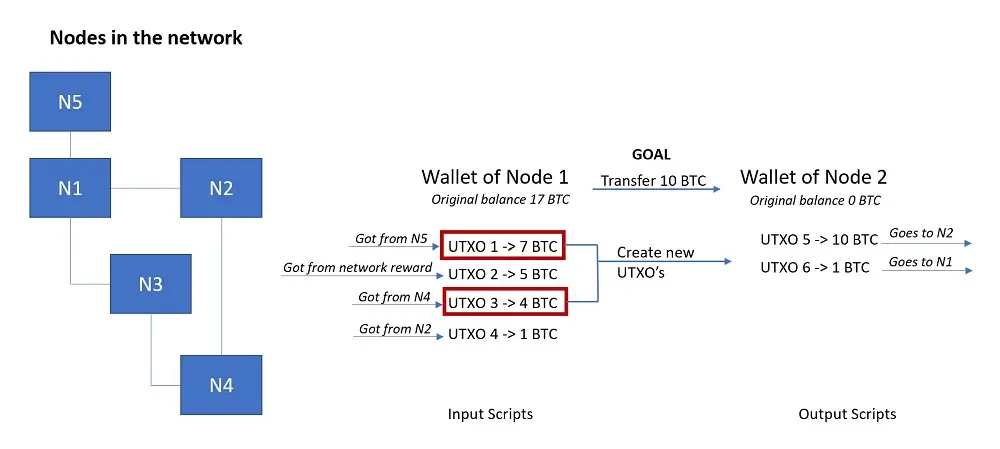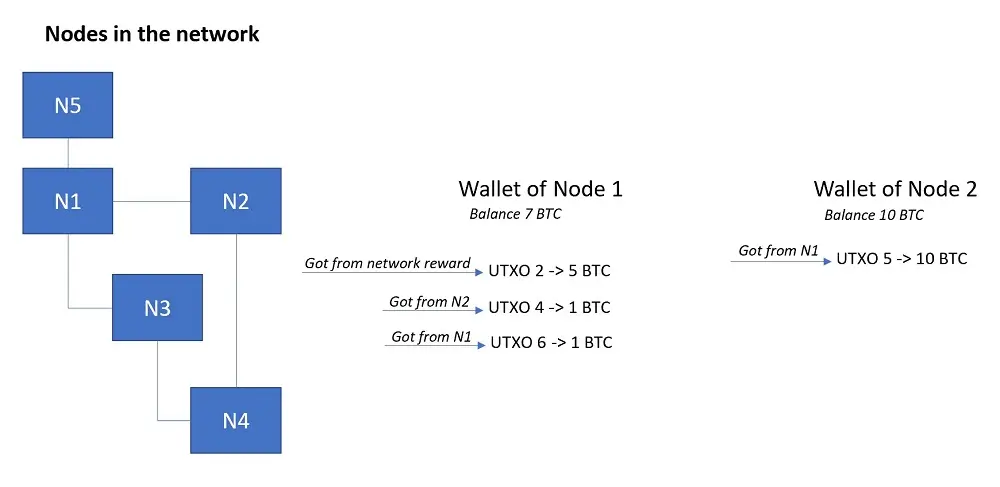UTXO (Unspent Transaction Output) in Crypto Blockchains

Every blockchain uses different record-keeping methods. In this guide, we will understand the UTXO (Unspent Transaction Output) method that Bitcoin and some other cryptocurrency blockchain networks use. We will also see how it differs from traditional banking systems’ popular account/balance method.
What is UTXO?
UTXO, or Unspent Transaction Output, is a fundamental concept in cryptocurrency, particularly in the context of blockchain technology. It serves as a critical component for maintaining the state of the network, which is essential for understanding the distribution and control of digital currency across various participants.
In traditional financial systems, record-keeping often revolves around tracking the balances of accounts, similar to how banks operate. Each account has a balance, and money is transferred directly between these accounts. This method is known as the Account/Balance model. However, Bitcoin and several other cryptocurrencies adopt a different approach to record-keeping, known as the UTXO model.
The UTXO model differs significantly from the traditional account-based approach. Instead of tracking balances in accounts, it keeps track of individual units of the currency that have not been spent. In this model, every transaction creates new UTXOs, representing the amount of digital currency available for a user to spend in future transactions.
Understanding the Unspent Transaction Output model is key to grasping the mechanics of Bitcoin and other similar cryptocurrencies. UTXO can be thought of as the digital equivalent of real-world cash. Just as cash transactions involve receiving, using, and giving change, UTXO represents the amount of digital currency that remains to be spent after a cryptocurrency transaction.
In summary, UTXO is a distinctive method for recording transactions and tracking cryptocurrency ownership. It is a cornerstone of Bitcoin’s blockchain technology, shifting from traditional account-based financial record-keeping to a more granular tracking of individual transaction outputs.
How Does UTXO Work?
Whenever a Blockchain transaction occurs in Bitcoin, it primarily consumes existing UTXOs (sending party balance) called inputs. It creates new UTXOs (the BTC credited to the receiving party) called outputs. The node can now further utilize the output from a transaction in the network.
1. Transaction Outputs as UTXOs:
In the UTXO model, when a transaction occurs, it generates outputs, which are recorded on the blockchain. These outputs represent specific amounts of cryptocurrency.
Each output from one transaction can serve as an input for a new transaction. However, until it’s used, this output is known as a UTXO.
Essentially, a UTXO is the amount of digital currency that a user has received and is able to spend.
2. Using UTXOs for New Transactions:
When a user initiates a new transaction, they use UTXOs as inputs. These are the funds available to them from previous transactions.
The transaction process involves referencing these UTXOs, indicating that the user wishes to transfer some or all of their value.
If the value of the UTXO exceeds the amount the user wishes to transfer, the transaction generates a change. This change becomes a new UTXO, which the user can spend in future transactions.
3. Transaction Verification:
In the Bitcoin network, miners and nodes verify transactions by ensuring that the UTXOs are valid and have not been previously spent. This is known as preventing double-spending.
Each UTXO has a unique identifier, and once it is used in a transaction, it cannot be used again, maintaining the integrity of the transaction history.
4. Analogies to Simplify Understanding:
Consider an analogy with cash transactions: If you have a $10 bill (a UTXO) and need to pay $6, you use this bill and receive $4 as a change. In the digital world, if you have a UTXO worth 10 Bitcoins and need to transfer 6, you use this UTXO, transferring 6 Bitcoins and creating a new UTXO of 4 Bitcoins as change.
By tracking each currency unit through UTXOs, the Bitcoin network ensures transparency and security in its transactions. This method stands in contrast to the traditional account-based systems, providing a decentralized and tamper-proof ledger of financial activity.
There are two ways to get the UTXO in a bitcoin network:
- Either from another node in the network
- As a reward from the network
Let’s see how this model applies to our sample transaction model. Refer to the diagram shown below:
Visual Transaction Flow in UTXO

Explanation
The diagram shows five blockchain nodes in the network labeled N1, N2, N3, N4, and N5. Here Node 1 (N1) wants to transfer 10 BTC to Node 2 (N2) in the network.
- Node 1 has a balance of 17 BTC received from other nodes in the network and as a reward from the network. Whereas the balance of node 2 is 0 BTC.
- All the transactions that Node 1 has received are individual UTXOs that are maintained.
- For Node 1 to transfer 10 BTC, it selects the UTXOs that can be combined to transfer to Node 2.
- In the example above, Node 2 sent UTXO 1, which it received from Node 5, and UTXO 3, which was received from Node 4, was sent to Node 2. A new UTXO of 11 BTC is created and sent to Node 2.
- Now in the wallet of Node 2, two new UTXOs will be created (represented as UTXO 5 and UTXO 6).
- UTXO 5 will go to the wallet of Node 2 as Node 1 intends to send a transaction of 10 BTC to Node 2, and UTXO 6 will be a self-addressed BTC that will come back to Node 1.
Once the transaction of the transfer of 10 BTC from Node 1 to Node 2 completes, the UTXOs of the Node 1 and Node 2 will be as follows:

Therefore, we can conclude that the transaction occurs in the network because of addresses, values, and scripts (input and output scripts).
Key Points to Keep in Mind
- Each UTXO represents a particular address, which is a public key.
- The corresponding private key (which only the owner of the corresponding UTXOs has) is to unlock and spend that UTXO.
- After the transaction completes, it again locks with the new owner’s public key and, therefore, requires the new owner’s private key to unlock again.
The UTXO model doesn’t store the balances of the nodes in the network but just the transaction outputs. Hence, the network does not maintain the balance of the nodes. Then, is there any way to check the total balance of the node in a network?
Yes. It is possible to check the total balance in the blockchain network. Every node in the network maintains a wallet, representing the total balance as the sum of UTXOs available in the node’s wallet.
UTXO in Bitcoin and Other Cryptocurrencies
The Unspent Transaction Output model is not only a fundamental aspect of Bitcoin’s blockchain architecture but also influences several other cryptocurrencies. Understanding its application across different platforms offers insight into the diverse approaches to blockchain technology.
- Use in Bitcoin:
- Bitcoin, the pioneering cryptocurrency, is the most prominent user of the UTXO model.
- In Bitcoin’s blockchain, UTXO is critical in ensuring that all transactions are accurately and securely recorded.
- Each Bitcoin transaction refers to previous transaction outputs as inputs, creating a chain of ownership that is verifiable and immutable. This chain forms the core of Bitcoin’s ledger integrity.
- Other Cryptocurrencies:
- Several cryptocurrencies derived from or inspired by Bitcoin’s technology also utilize the UTXO model. Examples include Bitcoin Cash, Litecoin, and others, which have adopted similar methodologies for tracking transactions.
- These cryptocurrencies use UTXO for its benefits in terms of enhanced security and privacy and its potential for parallel processing of transactions, which can lead to efficiency gains in certain scenarios.
UTXO Vs. Account Balance Record-keeping Models
In contrast to the UTXO model, some cryptocurrencies, like Ethereum, use an account-based model. This model is more akin to traditional banking systems, where balances are kept in accounts, and transactions directly transfer values between these accounts.
The key difference between the Account Balance and UTXO is that in the account balance, we store the entire balance of the nodes available in the network. In contrast, in UTXO, we store only the transaction outputs, not the balance. Let’s understand this further.
An account balance is for bank transfers, whereas UTXO is equivalent to the cash exchange. Let us consider there is a node in a network with no original balance.
Account Balance Method
In the Account Balance model, the total balance is maintained. Consider the above example. Now, the node will hold a total balance of 5 BTC. Now, if a node wants to transfer 1 BTC to another node, it can happen directly, and there is no need to take the balance bank. So, the balance of a node after the transfer will be 4 BTC.
The account-based model offers different benefits, such as greater simplicity in tracking account balances and facilitating more complex transaction types, like those used in smart contracts.
UTXO Method
In the UTXO method, if a node receives 5 BTC from two transactions where transaction 1 gave 2 BTC and transaction gave 3 BTC, instead of maintaining the total balance of 5 BTC, the ledger of the two transactions received is maintained.
This is very similar to the analogy of the wallet where we have the cash bills received, and if we want to check the total balance, we manually need to add up the cash bills available in the wallet.
Now, the node has two UTXOs of 2 BTC and 3 BTC. Consider now that this node needs to transfer 1 BTC to another node. It cannot directly transfer 1 BTC. Instead, it needs to transfer 2 BTC to the node, and it will get back one UTXO with the value of 1 BTC. Which is a different process than what we currently do in our online banking systems.
Hybrid Models and Innovations
The cryptocurrency landscape is continually evolving, with some newer platforms exploring hybrid models that incorporate elements of both UTXO and account-based systems.
These innovations aim to merge the advantages of UTXO’s security and privacy with the flexibility and functionality of account-based models.
In conclusion, while UTXO is a defining feature of Bitcoin and several other cryptocurrencies, it represents just one approach to digital currency record-keeping. The choice between UTXO and other models like account-based systems reflects varied priorities and technical strategies of different blockchain platforms.
Benefits and Challenges of the UTXO Model
The Unspent Transaction Output model, prominently used in Bitcoin and similar cryptocurrencies, brings unique advantages and certain challenges. Understanding these can provide deeper insight into why certain blockchain networks choose this model over others.
Benefits:
- Enhanced Privacy: UTXO contributes to user privacy. Each transaction creates new UTXOs, which do not directly link to specific user identities, unlike account-based models where all transactions are tied to a particular account.
- Transaction Verification Efficiency: The UTXO model can offer efficiencies in verifying transactions. Each UTXO is independent, allowing for parallel transaction processing potentially speeding up the verification process.
- Clear Transaction History: UTXOs provide a clear and straightforward transaction history. Each UTXO represents a discrete chunk of digital currency, making tracing its lineage through the blockchain easy.
- Double-Spending Prevention: The model inherently guards against double-spending. Since each UTXO can only be spent once, the network can easily verify whether it has been spent previously.
Challenges:
- Scalability Issues: The UTXO model can face scalability challenges. As the number of transactions grows, the UTXO set can become large and unwieldy, requiring more storage and processing power.
- Complexity for Users: Managing UTXOs can be complex for users. Unlike the straightforward account-balance model, users need to track multiple UTXOs as part of their wallet, which can become cumbersome.
- Transaction Size and Fees: Transactions in this model can become large if they involve many inputs (i.e., UTXOs), leading to higher transaction fees. This can be particularly problematic during periods of high network congestion.
- Less Intuitive for Everyday Use: For the average person, the UTXO model can be less intuitive than the account-based model. UTXOs and change outputs are less straightforward than simply deducting and adding to account balances.
In summary, the UTXO model offers significant advantages in terms of privacy and security, making it a popular choice for cryptocurrencies like Bitcoin.
However, it also faces challenges, particularly in terms of scalability and user experience. These trade-offs illustrate the ongoing evolution and diversification of blockchain technologies as different platforms strive to balance efficiency, security, and ease of use.
Conclusion: The Role and Significance of UTXO in Blockchain Technology
The Unspent Transaction Output (UTXO) model is more than just a technical feature of certain cryptocurrencies; it represents a significant approach to how digital transactions are recorded and managed in the blockchain space. Primarily associated with Bitcoin, this model has been instrumental in shaping the development and operation of various other cryptocurrencies.
UTXO’s Place in Blockchain Technology:
UTXO is a core component of Bitcoin’s blockchain architecture, providing a unique method for tracking the ownership and transfer of digital currency.
Its implementation highlights a departure from traditional, account-based financial systems, offering a decentralized and secure method of transaction recording.
Advantages and Challenges as Drivers of Innovation:
The benefits of UTXO, including enhanced privacy, security, and a clear audit trail, have been key factors in its adoption.
At the same time, the challenges it faces, particularly in terms of scalability and user-friendliness, have spurred innovation within the blockchain community. These challenges lead to developing new solutions and hybrid models that seek to combine the best aspects of UTXO and account-based systems.
Impact on the Cryptocurrency Landscape:
UTXO has played a significant role in the evolution of cryptocurrencies, influencing how transactions are processed and verified.
Its impact extends beyond Bitcoin, affecting the design and functionality of several other blockchain platforms.
Looking Forward:
As blockchain technology continues to evolve, the role of UTXO may change. Emerging technologies and increasing demands for scalability and efficiency are likely to shape its future adoption and adaptation.
The ongoing developments in blockchain and cryptocurrency are a testament to the dynamic nature of this field, where models like UTXO continue to be pivotal in discussions about digital currency and decentralized finance.
In conclusion, the UTXO model, with its distinct approach to transaction management, remains a vital part of the blockchain ecosystem. Its influence on Bitcoin and other cryptocurrencies is a reflection of the ongoing innovation and diversity within the realm of digital currencies.
As blockchain technology advances, the principles underlying UTXO will continue to be a critical reference point in the quest for more secure, transparent, and efficient transaction systems.

Tavish lives in Hyderabad, India, and works as a result-oriented data scientist specializing in improving the major key performance business indicators.
He understands how data can be used for business excellence and is a focused learner who enjoys sharing knowledge.
